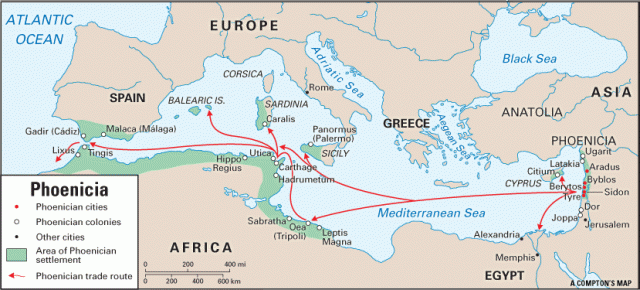Phoenicia
ANCIENT PHOENICIA, A LOOSE confederation of city-states existing between 3000 B.C.E. and 146 B.C.E., was located where LEBANON is now. The culture was known for seafaring commerce and trade, and colonizing. The most important legacy left by the Phoenicians, though, was a 22-character alphabet that became the basis of Hebrew, Greek, and Roman script. In 1600 B.C.E., an alphabet called proto-Canaanite was used in the east Mediterranean area. Proto-Canaanite consisted of 28 symbols standing for syllables and was based on Egyptian hieroglyphics. Over a few centuries, the Phoenicians developed their own alphabet from this. Because of their widespread trade, the Phoenicians were in a position to spread the writing they used all over the Mediterranean region. The Greeks adapted the alphabet in the 8th century B.C.E. and added vowel sounds and characters to indicate individual sounds, rather than syllables. This version spread to the Balkans, RUSSIA, and ITALY.

The Phoenicians had arrived in the Levant around 3000 B.C.E.; their original homeland is not known. They settled between the MEDITERRANEAN SEA and the mountains of LEBANON on a narrow strip of land. What they called themselves is not known; some inscriptions dating back to the 15th century B.C.E. refer to them as Canaanites. Initially, their major city was Sidon, and they were also called Sidonites in the Old Testament of the Bible. By 1200 B.C.E., the Phoenicians had built major port cities along the Mediterranean. Tyre soon surpassed Sidon in influence; other cities were Byblos, Akka, Aradus, and later, Berytus. These port cities were governed as independent city-states and ruled by hereditary kings.
The Phoenicians exploited all available resources in their homeland, including the rich forests. It was as traders, however, that they were best known. They harvested and shipped the cedars, pines, and cypresses of the Lebanon forests. Other products included textiles; Phoenicians became noted for the rich purple color of their cloth, which came from the snail in murex shells. Small hills of these discarded shells, several meters high, have been found while excavating ancient Sidon. Phoenicians were also known for their glassware, which was often clear; they may have invented glassblowing. Phoenicians may also have trafficked in slaves. Metal working became a Phoenician art. The metals came from as far away as Britain, IRELAND, SPAIN, and Brittany; the raw materials were imported through the network of colonies Phoenicians had established throughout the Mediterranean region.
Phoenician colonies, like their home cities, were often built on rocky promontories and islets with a view over harbors in highly defensible positions. The earliest Phoenician colony was Kition, on CYPRUS, a source of copper. In 1110 B.C.E., the Phoenicians founded Gades (Cadiz). Utica, in North Africa, was built in 1101. Malaca (Malaga), Joppa (Yafo), Leptis Magna (near present-day Tripoli), and many other
cities along the coasts of North Africa, southern Iberia, and the islands of the Mediterranean followed. By the 8th century, Phoenicians were trading beyond the Mediterranean, along the Atlantic coasts of Spain and MOROCCO, especially for metals such as copper, tin, and gold. In 814 B.C.E. they founded their most important colony, Carthage, near what is now Tunis. Herodotus claimed that the Phoenicians circumnavigated Africa, which took three years.
By 875 B.C.E., most—but not all—of the cities in Phoenicia were paying tribute to the Assyrian Empire, and within 150 years Phoenicia was annexed to that empire. The Assyrian Empire fell in 612 B.C.E., and in 539 B.C.E. Phoenicia became part of the PERSIAN EMPIRE. Phoenician colonies continued to trade and dominate the Mediterranean, governing themselves autonomously under the leadership of Carthage. Carthage controlled trade from the Straits of Gibralter, founded its own colonies in southern Spain, and continued to trade in metals as the original Phoenician cities had done. The area around Carthage produced rich harvests of grain, and the city controlled the export and sale of that as well. Carthage engaged in long-standing rivalry with Greek trading colonies such as Massalia (Marseilles).
The strong navy of Carthage dominated the Mediterranean until 241 B.C.E., when Rome, having consolidated power in Italy, wrested control of Sicily from Carthage in the First Punic War. During the Second Punic War in 218 B.C.E., the Carthaginian general, Hannibal, crossed the Alps into Italy with his army and elephants and defeated the Romans. But in 202 B.C.E., the Roman general Scipio Africanus beat Hannibal at Zama, and forced the Carthaginians to give up their control of Spain, limit their fleet, and pay heavy taxes. Over the years, Carthage began to return to strength, and in 146 B.C.E., Rome went to war with the city again. After a six-month siege, Rome completely destroyed the city, killed or enslaved all the inhabitants, and sowed the surrounding fields with salt so that nothing would grow there again.